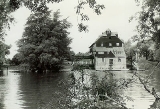
Houghton Mill
Encyclopedia
Houghton Mill is a water mill located on the Great Ouse in Houghton
, Cambridgeshire
, England
. It is a National Trust
property.
 Various mills have occupied this spot since the first building was erected in the year 969. In the Middle Ages, the mill was owned by the nearby Benedictine Abbey, and peasants were under an obligation to have their flour ground in the mill. Part of the flour was withheld as payment by the miller. When in 1500 the Abbot diverted the river water in order to supply the mill with sufficient power, the neighbouring village was flooded. The villagers rose up in protest, and fifteen years later they were granted permission to change the course of the water in case of an emergency.
Various mills have occupied this spot since the first building was erected in the year 969. In the Middle Ages, the mill was owned by the nearby Benedictine Abbey, and peasants were under an obligation to have their flour ground in the mill. Part of the flour was withheld as payment by the miller. When in 1500 the Abbot diverted the river water in order to supply the mill with sufficient power, the neighbouring village was flooded. The villagers rose up in protest, and fifteen years later they were granted permission to change the course of the water in case of an emergency.
At the Dissolution of the Monasteries
, ownership of the mill reverted to the Crown.
The best-known miller is the nineteenth-century Quaker Potto Brown
, a wealthy man who was so pious that he carried his ledgers to family prayer meetings in order to discuss with his Maker debts owed him. After his death, a bronze bust of him was erected.
The present building was probably built in the 17th century, and was extended in the 19th century. In the 1930s, the mill was decommissioned. Local residents bought the building and it was given to the National Trust. After the war, the mill was in use as a youth hostel, and was one of the few YHA
establishments where smoking was forbidden because of fire hazard.
In 1999, the National Trust put in new millstones. Flour is still being milled, and the building is a tourist centre, with a camping site nearby.
Houghton, Cambridgeshire
Houghton is a village in the English county of Cambridgeshire. Prior to 1974, it was part of the former county of Huntingdonshire. The village is in the civil parish of Houghton and Wyton and is situated between Huntingdon and St Ives on the A1123 road, and not far south of RAF Wyton...
, Cambridgeshire
Cambridgeshire
Cambridgeshire is a county in England, bordering Lincolnshire to the north, Norfolk to the northeast, Suffolk to the east, Essex and Hertfordshire to the south, and Bedfordshire and Northamptonshire to the west...
, England
England
England is a country that is part of the United Kingdom. It shares land borders with Scotland to the north and Wales to the west; the Irish Sea is to the north west, the Celtic Sea to the south west, with the North Sea to the east and the English Channel to the south separating it from continental...
. It is a National Trust
National Trust for Places of Historic Interest or Natural Beauty
The National Trust for Places of Historic Interest or Natural Beauty, usually known as the National Trust, is a conservation organisation in England, Wales and Northern Ireland...
property.
History

At the Dissolution of the Monasteries
Dissolution of the Monasteries
The Dissolution of the Monasteries, sometimes referred to as the Suppression of the Monasteries, was the set of administrative and legal processes between 1536 and 1541 by which Henry VIII disbanded monasteries, priories, convents and friaries in England, Wales and Ireland; appropriated their...
, ownership of the mill reverted to the Crown.
The best-known miller is the nineteenth-century Quaker Potto Brown
Potto Brown
Potto Brown was a miller and nonconformist philanthropist in Huntingdonshire, England. He is commemorated by a statue in the village of Houghton where he was born, lived and died. Local schools and churches are a monument to his philanthropy....
, a wealthy man who was so pious that he carried his ledgers to family prayer meetings in order to discuss with his Maker debts owed him. After his death, a bronze bust of him was erected.
The present building
Although there has been a mill on this site for most of Houghton's history, the original mill site (certainly in the time of the Domesday book) was approximately 0.4 miles along the river towards Huntingdon. The original mill pond is still there but now appears to be a natural backwater.The present building was probably built in the 17th century, and was extended in the 19th century. In the 1930s, the mill was decommissioned. Local residents bought the building and it was given to the National Trust. After the war, the mill was in use as a youth hostel, and was one of the few YHA
YHA
YHA may refer to:* YHA Australia, a youth hostel association in Australia* Youth Hostels Association , a youth hostel charity in the United Kingdom* Youth Hostel Association of New Zealand, a youth hostel association in New Zealand...
establishments where smoking was forbidden because of fire hazard.
In 1999, the National Trust put in new millstones. Flour is still being milled, and the building is a tourist centre, with a camping site nearby.

